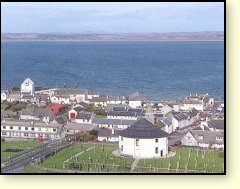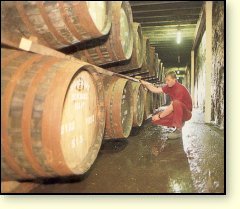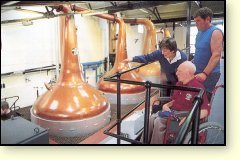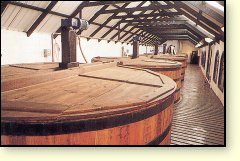
|
      
|
 |
Bowmore Distillery

 |
|
Location: School Street, Bowmore, Isle of Islay PA43 7GS
Hours: Daily guided tours: Mon-Fri 10.30am and 2pm
Summer: 11.30am and 3pm, Sat: 10.30am.
Party bookings by appointment - Admission charges
Reception centre, shop and video show
Phone: 01496-810441
|
Text from The Whisky Trails, Copyright © Gordon Brown 1993:
The town of Bowmore was ‘moved’ from what is now Bridgend in the late 1760s. It was the decision of the local laird, Daniel Campbell, and such relocations were almost a family trait; the Duke of Argyll, Clan Campbell Chief, had already done the same thing with Inveraray village on Loch Fyne on the mainland, moving the smells and noise of the hoi polloi from beneath the windows of his fine castle.

The distillery at Bowmore nestles on the shore. In the foreground is the famous Round Church.
|
Bowmore’s church, built in 1769, was circular in shape so as to deny the Devil corners in which to hide while he tried to tempt the congregation. It stood atop the hill outside the town and apart from it; the distillery was built at the bottom of the hill, snug within the town. Today the main street climbs up the hill to the church’s doors, the expanded town lying beyond the pavements on both sides.
The distillery was built in 1779, making it one of the oldest in Scotland. In those days whisky making was carried out all over the island, each bothy-operator aiming to supply himself and sell some on to local clientele. There was plenty such activity around Bowmore, since the town offered a relatively high density of population, and although most of this production was illicit, it tended to be very good.

The filled casks have to be checked regularly to ensure there are no ´leakers´.
|
Bowmore’s founder, David Simson, farmed and distilled at Bridgend and moved to Bowmore with the town. He was something of an entrepreneur, owning the little supply vessel that served the island, so no doubt some of his whisky penetrated to the far-off urbanity of Glasgow on the mainland. The Simson family sold out in 1837 to the Mutters, of whom James was the Ottoman, Portuguese and Brazilian vice-consul in Glasgow and also had farming interests on the island. Islay has lush, fertile soil and, as well as cropping wheat and, appropriately, barley, Mutter introduced clover to the island for use as animal fodder. When the distillery was expanded an aqueduct channelled more water from the River Laggan. The family sold the distillery in 1892 and there was a succession of owners over the next 50 years or so. One of Bowmore’s grain lofts was used during the last war as a Coastal Command operations room to monitor and control great Sunderland and Catalina flying boats, which flew countless U-boat-spotting sorties into the Atlantic. In 1963, whisky-brokers, Stanley P. Morrison Ltd., bought the distillery and have developed the whisky into a high-profile international brand which has continuously won top awards in international tasting competitions. Bowmore whisky was bought for despatch to Windsor Castle on behalf of Queen Victoria on more than one occasion and, while the appropriate invoice may have been issued, the monarch was required to pay no duty; a principle with which the smugglers of Islay and elsewhere had long agreed.
The pagoda heads show attractive individuality. The crests are onion-shaped like transplants from the Kremlin in Moscow and, taken together with the flat-brimmed eaves, look like the hats worn by Canadian Mounties. The stillhouse holds four copper stills and many of the other large vessels in the distillery are also made of copper – unusual in today’s distilleries where stainless steel has made great inroads to wood and cast iron. Also very rare are Bowmore’s three floor maltings and kiln which are still in use. No fuel is used for the kilning process for which blowers push air through the malt from radiators heated by waste water from the distilling process. Precise amounts of peat are burned only to impart the required degree of aroma and flavour. The original storage cellars at Bowmore go underground and contain a cask of 1981 vintage that was presented to the present Queen on her visit there. It’s maturing nicely for now. General Manager James MacEwan could be described as the all-round whisky man; in his time he has also been a cooper and a whisky-blender. Very much a part of the community, the distillery also uses that waste hot water from the distillation process to heat the island’s swimming pool in one of the warehouses that was gifted by Bowmore Distillery to the townspeople.
The Whisky
Text from The Whisky Trails, Copyright © Gordon Brown 1993:

Bowmres four stills can be viewed from the visitors gallery.
|
Bowmore is a classic Islay malt that has a lighter persona but retaining a beautiful balance of peat with good, firm iodine-and-seashore complexity. It has great floral finesse and has been increasing in popularity in recent years. Bowmore is generous in the different ages and strengths at which it is released, with Bowmore Legend 12, 17, 21 and 25-year-old as well as 22 and 30 year old ceramics.

The tun room has recently been refurbished. The vessels are made of Oregon pine.
|
Source of water
Laggan river
|
|  |
 |
|